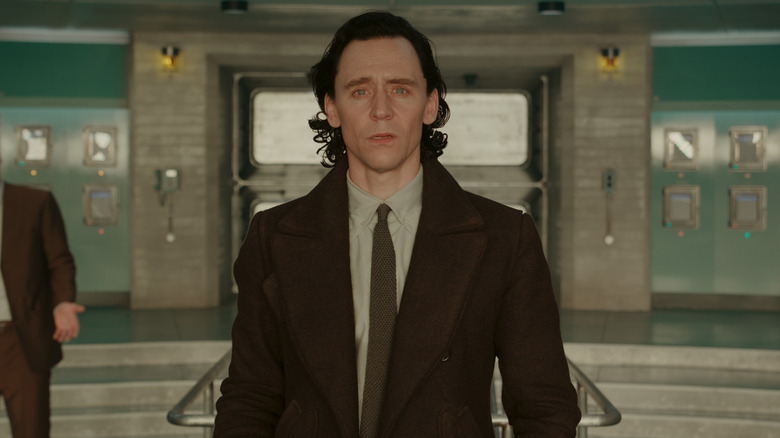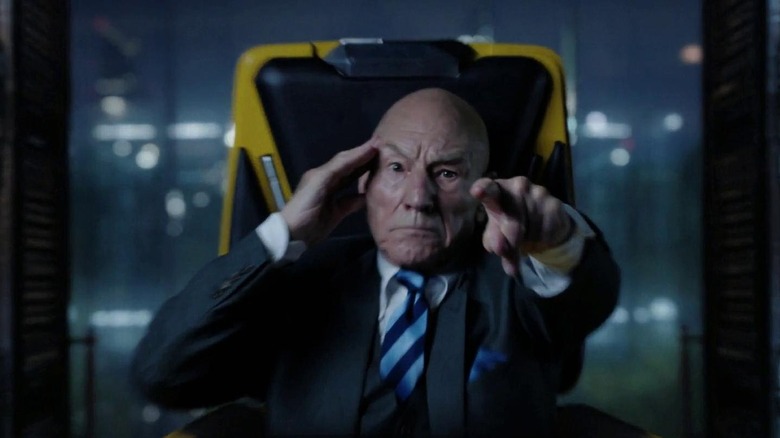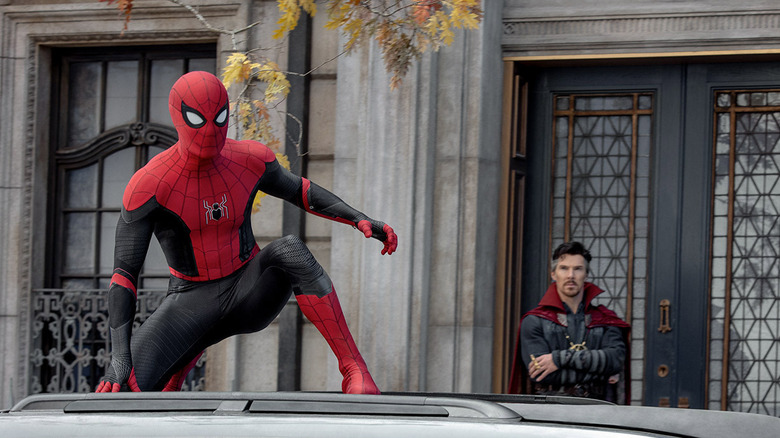Kevin Feige Teased The Converging Or Crashing Of MCU Timelines After Marvel's Phase Four
By Marvel's own estimation, Phase 4 of the Marvel Cinematic Universe was the largest yet. It incorporated seven feature films ("Black Widow" through "Black Panther: Wakanda Forever") and eight seasons of television ("WandaVision" through "She-Hulk: Attorney at Law"). All told, there were more screen hours in Phase 4 than in the previous three phases combined. As of this writing, two additional films have been released as part of Phase 5 ("Ant-Man and The Wasp: Quantumania" and "Guardians of the Galaxy Vol. 3," with a third — "The Marvels" — in theaters now. Two seasons of TV have also been part of the new Phase, including "Secret Invasion" and the second season of "Loki."
The most significant chapters throughout the above Phases are probably "Loki," "Spider-Man: No Way Home," "Doctor Strange in the Multiverse of Madness," and "Ant-Man and the Wasp: Quantumania," as those are the films and shows that deal directly with the notion of the multiverse. "Morbius" does as well, as do the two animated "Spider-Verse" movies. Thanks to those films, audiences have already seen characters from pre-existing superhero franchises — the ones previously owned by Fox or Sony — infiltrate the Disney-owned MCU. Rather than accept these movies as stories unto themselves, the multiverse allows them all to interact. Any and all dead characters and franchises can now be resurrected via portals to other dimensions where they still live. Kang (Jonathan Majors), the central villain from "Quantumania," is to be the franchise's new time-hopping multiverse antagonist.
In the new book "The Marvel Cinematic Universe An Official Timeline," authored by Anthony Breznican, Amy Ratcliffe, and Rebecca Theodore-Vachon, Marvel Studios head honcho Kevin Feige went on record with a tantalizing thought: some of the extant timelines may "crash" or "converge."
Crashing and converging
This means, likely, that characters from older Marvel movies are now ripe for incorporation into the MCU. This is, of course, a natural extension of some of the other cameos already provided in previous movies. Tobey Maguire, Andrew Garfield, and Tom Holland all appeared on screen as parallel Spider-Men in "No Way Home," and "Multiverse of Madness" already featured Patrick Stewart playing Professor X from the "X-Men" movies.
In the upcoming film "Deadpool 3," Hugh Jackman will similarly return as Wolverine, although which Wolverine from which universe remains unclear. But we might have gotten a hint, thanks to the mid-credits scene in "The Marvels," where Monica Rambeau ends up in an alternate universe. This scene not only includes an appearance by Kelsey Grammer as Beast from Fox's "X-Men" movies, albeit with a CGI makeover, but there's also a different version of Monica's mother Maria Rambeau (Lashana Lynch) who is alive and well and has become the hero known as Binary in this universe.
The book points out, however, that there is a Sacred Timeline (something talked about in "Loki") that doesn't include every single Marvel character from throughout the media's history.
Confusingly, in "Multiverse of Madness," the "main" universe of the MCU was referred to as Earth-616, the name most often given to the "main" universe in Marvel Comics. It seems that the MCU is trying to stand in as the live-action version of Marvel Comics. The MCU does not exist in a world parallel to the printed page.
But everything may be fair game. Feige wrote in his foreword:
"On the Multiverse note, we recognize that there are stories — movies and series — that are canonical to Marvel but were created by different storytellers during different periods of Marvel's history. The timeline presented in this book is specific to the MCUs Sacred Timeline through Phase 4. But, as we move forward and dive deeper into the Multiverse Saga, you never know when timelines may just crash or converge (hint, hint/spoiler alert)."
The "Hint, hint" and "spoiler alert" could merely indicate that Feige is being playful, although it's just as likely he is referring to an upcoming multidimensional conflagration that would compress multiple timelines into one.
That whole Secret Wars thing
"I am from beyond! Slay your enemies and all that you desire shall be yours! Nothing you dream of is impossible for me to accomplish!"
So said The Beyonder, an obscure Marvel Comics villain, at the head of the 1984 Marvel Comics crossover event "Secret Wars." In "Secret Wars," all of Marvel's most popular heroes were scooped up from their jobs superhero-ing and whisked into a parallel universe where a hundred characters could all fight each other at the behest of The Beyonder. "Secret Wars" was the flimsiest story imaginable and only existed to answer multiple schoolyard "Who would win in a fight" arguments without having to invent any palpable reasons as to why heroes and villains might be fighting each other.
Currently on the MCU docket is a 2027 film called "Avengers: Secret Wars," a massive crossover event — from Phase 6! — that would likely involve every single Marvel movie character to date, perhaps even going back as far as "Red Sonja" in 1985. Thanks to multiverse shenanigans, extensive timeline hopping, and multiple parallel versions of characters already having met, there's every reason to believe that Feige will incorporate multiple known Marvel characters from previous franchises. It's also likely that "Secret Wars" will serve as a streamlining device, allowing all the most popular characters to remain in the "main" universe after the conflagration and sending the unneeded characters either to their graves or back to their home dimensions.
What are your favorite Marvel characters from any media in the last 40 years? Whoever they are, they're now on standby. Let's see if audience's attention spans are long enough to see the event through.
Get ready for more Morbius.


